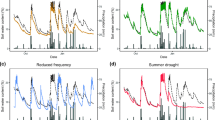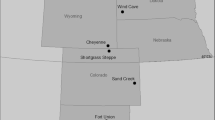Abstract
Growing evidence indicates that ecosystem processes may be differentially sensitive to dry versus wet years, and that current understanding of how precipitation affects ecosystem processes may not be predictive of responses to extremes. In an experiment within a mesic grassland, we addressed this uncertainty by assessing responses of two key carbon exchange processes—aboveground net primary production (ANPP) and soil respiration (Rs)—to an extensive gradient of growing season precipitation. This gradient comprised 11 levels that specifically included extreme values in precipitation; defined as the 1st, 5th, 95th, and 99th percentiles of the 112-year climate record. Across treatments, our experimental precipitation gradient linearly increased soil moisture availability in the rooting zone (upper 20 cm). Relative to ANPP under nominal precipitation amounts (defined as between the 15th and 85th percentiles), the magnitude of ANPP responses were greatest to extreme increases in precipitation, with an underlying linear response to both precipitation and soil moisture gradients. By contrast, Rs exhibited marginally greater responses to dry versus wet extremes, with a saturating relationship best explaining responses of Rs to both precipitation and soil moisture. Our findings indicate a linear relationship between ANPP and precipitation after incorporating responses to precipitation extremes in the ANPP–precipitation relationship, yet in contrast saturating responses of Rs. As a result, current linear ANPP–precipitation relationships (up to ~ 1000 mm) within mesic grasslands appear to hold as appropriate benchmarks for ecosystems models, yet such models should incorporate nonlinearities in responses of Rs amid increased frequencies and magnitudes of precipitation extremes.




Similar content being viewed by others
References
Ahlstrom A, Raupach M, Schurgers G et al (2015) The dominant role of semi-arid ecosystems in the trend and variability of the land CO2 sink. Science 348:895–899
Briggs J, Knapp A (1995) Interannual variability in primary production in tallgrass prairie: climate, soil moisture, topographic position, and fire as determinants of aboveground biomass. Am J Bot 82:1024–1030
Ciais P, Reichstein M, Viovy N et al (2005) Europe-wide reduction in primary productivity caused by the heat and drought in 2003. Nature 437:529–533
Cottingham K, Lennon J, Brown B (2005) Knowing when to draw the line: designing more informative ecological experiments. Front Ecol Environ 3:145–152
Dietrich J, Smith M (2016) The effect of timing of growing season drought on flowering of a dominant C4 grass. Oecologia 181:391–399
Estiarte M, Vicca S, Peñuelas J et al (2016) Few multiyear precipitation-reduction experiments find a shift in the productivity-precipitation relationship. Glob Change Biol 22:2570–2581
Fay P, Carlisle J, Knapp A, Blair J, Collins S (2003) Productivity responses to altered rainfall patterns in a C 4-dominated grassland. Oecologia 137:245–251
Frank D, Reichstein M, Bahn M et al (2015) Effects of climate extremes on the terrestrial carbon cycle: concepts, processes and potential future impacts. Glob Change Biol 21:2861–2880
Gherardi L, Sala O (2015) Enhanced interannual precipitation variability increases plant functional diversity that in turn ameliorates negative impact on productivity. Ecol Lett 18:1293–1300
Gotelli N, Ellison A (2013) A primer of ecological statistics, 2nd edn. Sinaur Associates Inc, Sunderland
Gutschick V, BassiriRad H (2003) Extreme events as shaping physiology, ecology, and evolution of plants: toward a unified definition and evaluation of their consequences. New Phytol 160:21–42
Haverd V, Ahlström A, Smith B, Canadell J (2016) Carbon cycle responses of semi-arid ecosystems to positive asymmetry in rainfall. Glob Change Biol 23:793–800
Hawkes C, Waring B, Rocca J, Kivlin S (2017) Historical climate controls soil respiration responses to current soil moisture. Proc Natl Acad Sci 114:6322–6327
Heisler-White J, Knapp A, Kelly E (2008) Increasing precipitation event size increases aboveground net primary productivity in a semi-arid grassland. Oecologia 158:129–140
Hoover D, Knapp A, Smith M (2014) Resistance and resilience of a grassland ecosystem to climate extremes. Ecology 95:2646–2656
Hoover D, Knapp A, Smith M (2016) The immediate and prolonged effects of climate extremes on soil respiration in a mesic grassland. J Geophys Res Biogeosci 121:1034–1044
Hsu J, Powell J, Adler P (2012) Sensitivity of mean annual primary production to precipitation. Glob Change Biol 18:2246–2255
Huxman T, Smith M, Fay P et al (2004) Convergence across biomes to a common rain-use efficiency. Nature 429:651–654
IPCC (2012) Managing the Risks of Extreme Events and Disasters to Advance Climate Change Adaptation. A special report of working groups I and II of the intergovernmental panel on climate change, Cambridge University Press, Cambridge, UK, and New York, USA, p 582
Kayler Z, De Boeck H, Fatichi S et al (2015) Experiments to confront the environmental extremes of climate change. Front Ecol Environ 13:219–225
Knapp A (2002) Rainfall variability, carbon cycling, and plant species diversity in a mesic grassland. Science 298:2202–2205
Knapp A, Smith M (2001) Variation among biomes in temporal dynamics of aboveground primary production. Science 291:481–484
Knapp A et al (1998) Grassland dynamics, 1st edn. Oxford University Press, New York
Knapp A, Beier C, Briske D et al (2008) Consequences of more extreme precipitation regimes for terrestrial ecosystems. Bioscience 58:811
Knapp A, Avolio M, Beier C et al (2017a) Pushing precipitation to the extremes in distributed experiments: recommendations for simulating wet and dry years. Glob Change Biol 23:1774–1782
Knapp A, Ciais P, Smith M (2017b) Reconciling inconsistencies in precipitation–productivity relationships: implications for climate change. New Phytol 214:41–47
Koerner S, Collins S (2014) Interactive effects of grazing, drought, and fire on grassland plant communities in North America and South Africa. Ecology 95:98–109
Lauenroth W, Sala O (1992) Long-term forage production of North American shortgrass steppe. Ecol Appl 2:397–403
Liu L, Wang X, Lajeunesse M et al (2016) A cross-biome synthesis of soil respiration and its determinants under simulated precipitation changes. Glob Change Biol 22:1394–1405
Lloyd J, Taylor J (1994) On the temperature dependence of soil respiration. Funct Ecol 8:315
Luo Y, Jiang L, Niu S, Zhou X (2017) Nonlinear responses of land ecosystems to variation in precipitation. New Phytol 214:5–7
Maes W, Steppe K (2012) Estimating evapotranspiration and drought stress with ground-based thermal remote sensing in agriculture: a review. J Exp Bot 63:4671–4712
McConnaughay K, Coleman J (1999) Biomass allocation in plants: ontogeny or optimality? A test along three resource gradients. Ecology 80:2581–2593
Moyano F, Manzoni S, Chenu C (2013) Responses of soil heterotrophic respiration to moisture availability: an exploration of processes and models. Soil Biol Biochem 59:72–85
Nippert J, Knapp A, Briggs J (2006) Intra-annual rainfall variability and grassland productivity: can the past predict the future? Plant Ecol 184:65–74
Nippert J, Wieme R, Ocheltree T, Craine J (2012) Root characteristics of C4 grasses limit reliance on deep soil water in tallgrass prairie. Plant Soil 355:385–394
Poulter B, Frank D, Ciais P et al (2014) Contribution of semi-arid ecosystems to interannual variability of the global carbon cycle. Nature 509:600–603
R Core Team (2018) R: a language and environment for statistical computing. R Foundation for Statistical Computing, Vienna, Austria. https://www.R-project.org/
Ransom MD, Rice CW, Todd TC, Wehmueller WA (1998) Soils and soil biota. In: Knapp AK, Briggs JM, Hartnett DC, Collins SL (eds) Grassland dynamics: long-term ecological research in tallgrass prairie. Oxford University Press, NewYork, pp 48–68
Reichstein M, Bahn M, Ciais P et al (2013) Climate extremes and the carbon cycle. Nature 500:287–295
Sala O, Gherardi L, Reichmann L, Jobbagy E, Peters D (2012) Legacies of precipitation fluctuations on primary production: theory and data synthesis. Philos Trans R Soc B Biol Sci 367:3135–3144
Shi Z, Thomey M, Mowll W et al (2013) Differential effects of extreme drought on production and respiration: synthesis and modeling analysis. Biogeosciences 11:621–633
Smith M (2011) An ecological perspective on extreme climatic events: a synthetic definition and framework to guide future research. J Ecol 99:656–663
Taylor P, Cleveland C, Wieder W, Sullivan B, Doughty C, Dobrowski S, Townsend A (2017) Temperature and rainfall interact to control carbon cycling in tropical forests. Ecol Lett 20:779–788
Van de Pol M, Jenouvrier S, Cornelissen J, Visser M (2017) Behavioural, ecological and evolutionary responses to extreme climatic events: challenges and directions. Philos Trans R Soc B 372:20160134
Wilcox K, von Fischer J, Muscha J, Petersen M, Knapp A (2014) Contrasting above- and belowground sensitivity of three Great Plains grasslands to altered rainfall regimes. Glob Change Biol 21:335–344
Wilcox K, Shi Z, Gherardi L et al (2017) Asymmetric responses of primary productivity to precipitation extremes: a synthesis of grassland precipitation manipulation experiments. Glob Change Biol 23:4376–4385
Wu Z, Dijkstra P, Koch G, Peñuelas J, Hungate B (2011) Responses of terrestrial ecosystems to temperature and precipitation change: a meta-analysis of experimental manipulation. Glob Change Biol 17:927–942
Yahdjian L, Sala O (2006) Vegetation structure constrains primary production response to water availability in the Patagonian steppe. Ecology 87:952–962
Zhang B, Tan X, Wang S et al (2017) Asymmetric sensitivity of ecosystem carbon and water processes in response to precipitation change in a semi-arid steppe. Funct Ecol 31:1301–1311
Zscheischler J, Reichstein M, Harmeling S, Rammig A, Tomelleri E, Mahecha M (2014) Extreme events in gross primary production: a characterization across continents. Biogeosciences 11:2909–2924
Acknowledgements
The authors would like to first and foremost thank the Konza Prairie Biological Station (KPBS) and those affiliated for allowing this project to be possible. In particular, we would like to thank P. O’Neal and J. Larkins of the KPBS for technical support during the project. We would like to thank J. Dietrich, M. Johnston, M. Shields, A. Hoffman, L. Baur, L. Vilonen, M. Clark, M. Updike, R. Griffin-Nolan, A. Post, Q. Yu and W. Mau for assistance in the field. We are grateful for partial financial support to AJF from The Nature Conservancy J.E. Weaver Competitive Grant, The Colorado State University Graduate Degree Program in Ecology, and Western Agricultural Innovations. Support was provided to MDS and AKK by the Konza Prairie Long-term Ecological Research Program, the Drought-Net Research Coordination Network funded by the US National Science Foundation (DEB-1354732) and by the Macrosystems Biology/Emerging Frontiers Programs (EF-1239559, EF-1137378).
Author information
Authors and Affiliations
Contributions
AJF, AKK, and MDS conceived and designed the study. AJF performed the field research, statistical analyses, and wrote the first draft. All authors contributed to subsequent revisions.
Corresponding author
Ethics declarations
Conflict of interest
The authors declare that they have no conflict of interest.
Additional information
Communicated by Heather Throop.
We reveal contrasting sensitivities of grassland carbon inputs versus losses to large changes in precipitation and soil moisture through a novel gradient experimental design. Our work advances a predictive understanding of climate change impacts on grassland functioning.
Electronic supplementary material
Below is the link to the electronic supplementary material.
Rights and permissions
About this article
Cite this article
Felton, A.J., Knapp, A.K. & Smith, M.D. Carbon exchange responses of a mesic grassland to an extreme gradient of precipitation. Oecologia 189, 565–576 (2019). https://doi.org/10.1007/s00442-018-4284-2
Received:
Accepted:
Published:
Issue Date:
DOI: https://doi.org/10.1007/s00442-018-4284-2




